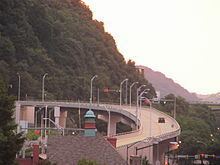Status in use No. of tracks 2 (1903–1944) Length 3342 ft (1019 m) | Work begun 1902 | |
 | ||
Opened 1903;closed circa 1948;reopened to vehicular traffic 2004 Track gauge 4 ft 8 ⁄2 in (1435 mm) (1903–1944) Owner Port Authority of Allegheny County | ||
The Wabash Tunnel is a former railway tunnel and presently an automobile tunnel through Mt. Washington in the city of Pittsburgh, Pennsylvania, United States. Constructed early in the 20th century by railroad magnate George J. Gould, it was closed to trains and cars between 1946 and 2004.
Contents
- Map of Wabash Tunnel Pittsburgh PA USA
- Operation as a railroad tunnel
- Conversion to a transitway
- Use as a bus garage
- Conversion to a roadway
- Operators
- Incidents
- References
Map of Wabash Tunnel, Pittsburgh, PA, USA
Operation as a railroad tunnel
Conceived in the late 1800s, the tunnel was built in 1903 for Gould's Wabash Railroad venture into Pittsburgh, which failed in 1908. It carried passenger trains into the city until 1931, and freight trains until 1946. After the end of train service, the tunnel sat empty for many years. The tunnel was once connected to the Wabash Bridge across the Monongahela River, but this was demolished in 1948, and was not replaced. Its two stone support piers remain in the river.
Conversion to a transitway
In the early 1970s the Port Authority of Allegheny County (PAT) spent US$6 million (US$35.5 million today) rebuilding the tunnel for the never-to-be-operational Skybus people mover system. (This project was to include a new Monongahela River bridge.)
Use as a bus garage
During this period, the tunnel was used to hold up to 87 of PAT's disused 1950s-era transit buses in reserve. The tunnel portals were reinforced to deter vandals, to the satisfaction of PAT's insurers. Despite this, in 1980, vandals gained access and smashed hundreds of windows and headlights on the two rows of buses parked inside.
Conversion to a roadway
By 1992, the Pennsylvania Department of Transportation (PennDOT) was considering using the Wabash Tunnel as a roadway to compensate for an upcoming closure of the Fort Pitt Tunnel. As part of the conversion to a roadway, the guideways for the Skybus system were removed and replaced with new paving and drainage. When awarded in 1994, the contract for this work was worth US$3.2 million (US$5.2 million today). However, in 1995, PAT declined to build a new road bridge (estimated at $US25.8 million, or US$40.6 million today) to connect the tunnel with downtown Pittsburgh.
On July 23, 2003 PAT approved contracts for US$10.9 million (US$14.2 million today) to build high-occupancy vehicle (HOV) ramps and modernized the tunnel, as well as provide a 172-space park-and-ride lot along Woodruff Street. The little-used HOV lane was opened on December 27, 2004, running from West Carson St. on the South Side and through the tunnel to Woodruff St. in Mt. Washington. The Fort Pitt Tunnel to the west and the Liberty Tunnels to the east carry nearly all of the vehicular traffic heading downtown.
On November 6, 2013 the Federal Transit Administration lifted the car pool requirements to provide an alternate route for drivers, due to the two-year closure of outbound West Carson Street.
Operators
Originally built for the Wabash Railroad, the Pittsburgh and West Virginia Railroad acquired it along with most of the ex-Wabash-Railroad property in 1917.
The tunnel was sold in 1931 to Allegheny County for $US3 million, (US$47.2 million today). The county intended to convert it to a road and use it to relieve the traffic congestion in the Liberty Tunnels, and in 1933 commissioned a $5000 study to investigate this concept.
As of April 2006, the tunnel was operated and maintained for PAT by Bruce & Merrilees, at an annual cost of $780,000.
Incidents
The tunnel's north portal was severely damaged in a 1925 landslide. The tunnel was temporarily closed due to fallen trees on July 19, 2012.
